Duplantis dominance reaches five years
Undefeated Swede's three world records lead to men's athlete of the year selection
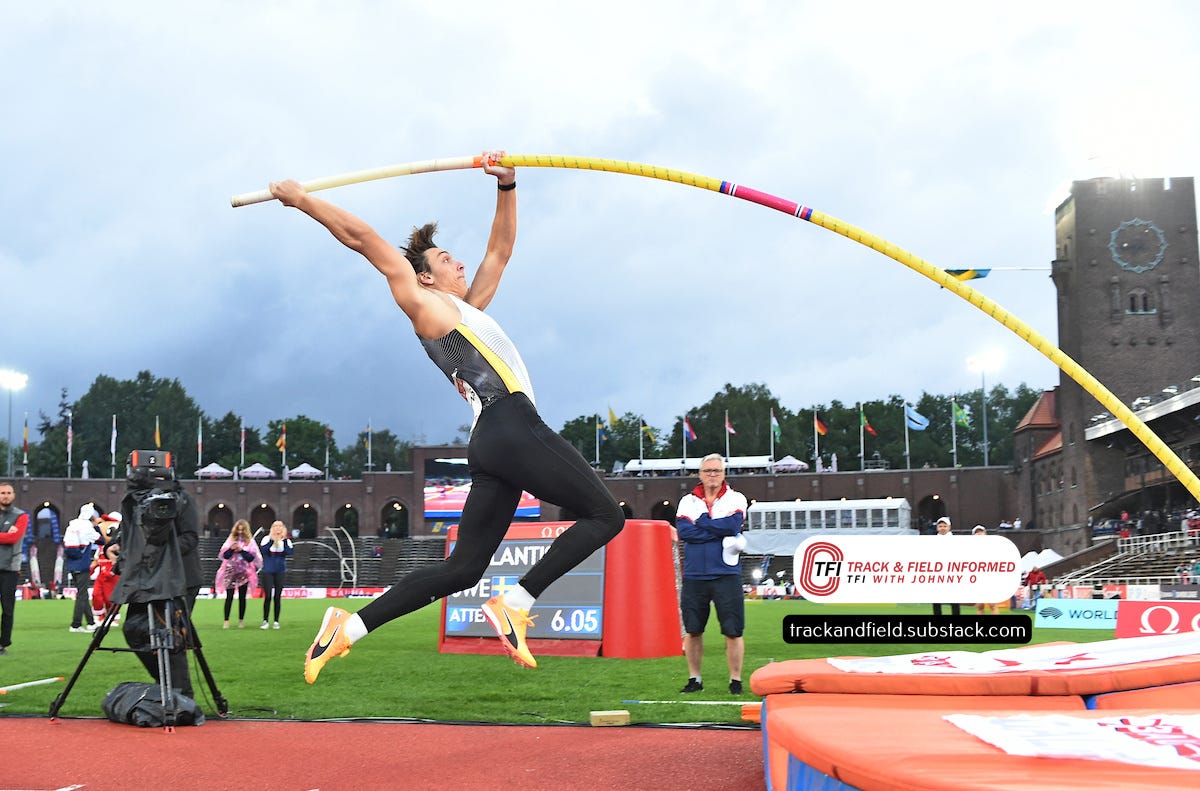
80 and 3.
That is the win-loss record in the men’s pole vault for Mondo Duplantis since the Swedish superstar by way of Lafayette, Louisiana, was last beaten in a global title meet.
Duplantis and American Sam Kendricks had both cleared 5.97 meters (19 feet 7 inches) on their third attempts in the World Athletics Championships in Doha, Qatar, on Oct. 1 of 2019. But Kendricks won his second consecutive title because he had fewer misses during the competition than did the 19-year-old Duplantis.
Kendricks is still one of the top vaulters in the world, as evidenced by his silver medal-winning performance in the Olympics Games in Paris in August. But Duplantis has taken the pole vault to never-before-seen heights as he won his second consecutive Olympic title while clearing a then-world record of 6.25 (20-6) in the Stade de France.
That height was 30 centimeters — and nearly a foot — higher than the 5.95 (19-6¼) that Kendricks cleared and it was the second world record of the year for Duplantis and the ninth of his illustrious career. It also made him only the third man in history to have set a world record in the pole vault in the Olympic Games, and the first since Wladyslaw Kozakiewicz of Poland cleared 5.78 (18-11½) in the 1980 Games in Moscow.
“I haven’t processed how fantastic that moment was,” Duplantis said in World Athletics post at the time. “It’s one of those things that don’t really feel real, such an out of body experience.
“What can I say? I just broke a world record at the Olympics – the biggest possible stage for a pole vaulter. The biggest dream since I was a kid was to break the world record at the Olympics, and I’ve been able to do that in front of the most ridiculous crowd I’ve ever competed in front of.”
Although Duplantis would set the 10th world record of his career — and the third of the year — when he cleared 6.26 (20-6½) in the Kamila Skolimowska Memorial Diamond League meet in Chorzow, Poland, nearly three weeks after his Olympic triumph, the cheering of 70,000-plus fans in Paris was something to behold and might have been the highlight of a year in which he was undefeated in 15 competitions and was a clear choice for men’s athlete of the year.
Americans Grant Holloway and Rai Benjamin had outstanding seasons in the 110-meter high hurdles and the 400 intermediate hurdles, respectively, in 2024. And Kenyan Emmanuel Wanyonyi was the top performer in the 800 meters during a revolutionary season in that event. But their competitive campaigns did not match the one put forth by Duplantis, whose American father, Greg, was a national-class pole vaulter during the 1990s and whose Swedish mother, Helena, is a former heptathlete and volleyball player.
“This is always special and hard to wrap my head around,” Duplantis said in a recorded message that was played at World Athletics’ annual gala in Monaco on Dec. 1 when he was honored as the organization’s men’s field event athlete of the year. “I am very appreciative. There is nothing more important than an Olympic year for us athletes, so I’m grateful things worked out the way they did and I performed the way I did.
“I can’t give enough thanks to my family who are my team – my mum and dad are my trainer and technical coach. I couldn’t be in the situation I’m in today without them, fighting for world and Olympic gold medals and doing things I dreamed of since I was a little kid.
“Right now I’m back in the United States working for next year. Thanks so much – this award truly means so much to me and my family.”
While Duplantis produced the three highest jumps of his career this year, his four-meet indoor season was not a great one by his standards as his highest clearance — 6.05 (19-10¼) in the World Athletics Indoor Championships in March — was well short of the 6.22 (20-4¾) he cleared for the sixth world record of his career in an indoor meet in Clermont-Ferrand, France, in February of 2023.
Nonetheless, he kicked off his outdoor season by raising the world record to 6.24 (20-5½) in the Diamond League opener in Xiamen, China, on April 20.
Duplantis was perfect during the competition, clearing 5.62 (18-5¼), 5.82 (19-1), 6.00 (19-8 ¼), and 6.24 on his first attempts.
The 6.24 clearance bettered the previous world record of 6.23 (20-5¼) that he had set in the Prefontaine Classic in Eugene, Oregon, in September of 2023. But while he had grazed the bar on his record clearance in that meet, he had room to spare in Xiamen.
“The indoor season wasn’t really what I wanted it to be,” Duplantis said in an interview on the Peacock broadcast. “I feel like it was a little bit all over the place, a little sloppier than I would have liked. So I think that I brought a little of that fire from the indoors. And I just wanted to do a little better.”
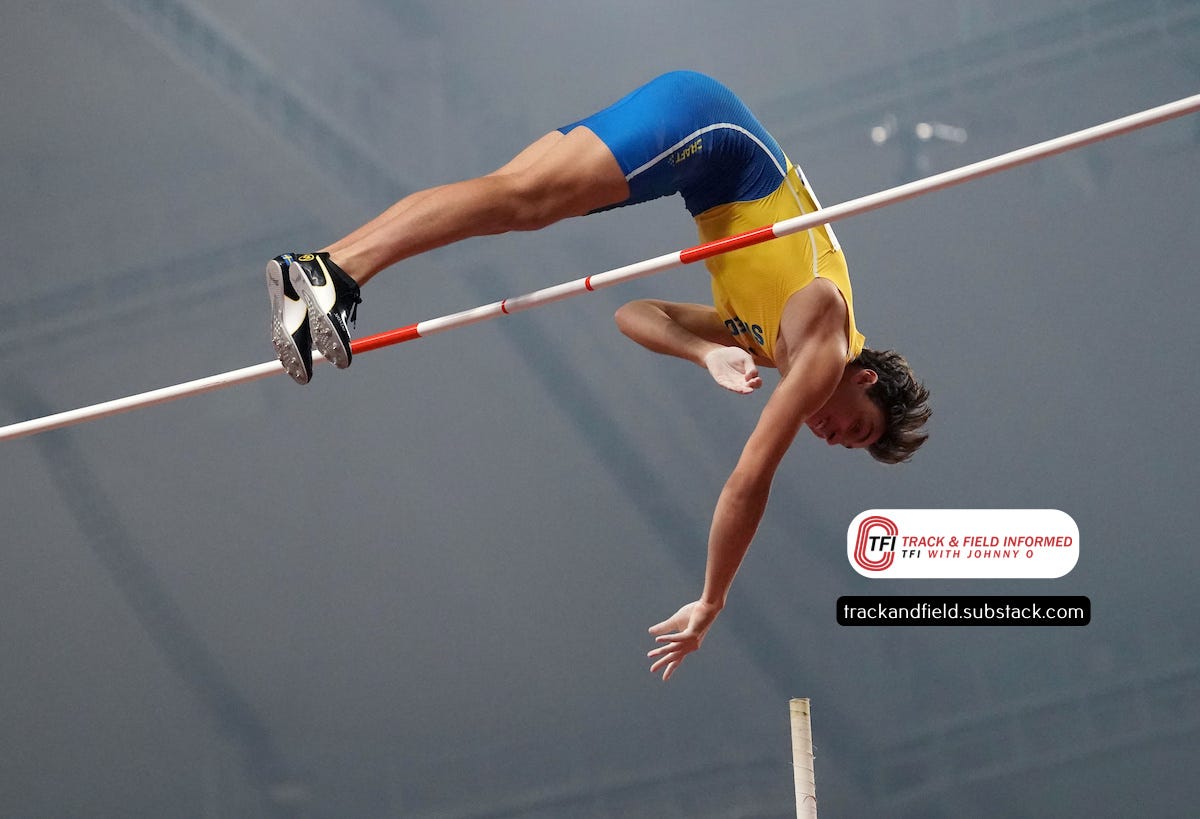
He added that he knew he was in “pretty good shape” and he felt good during the competition.
He commented on the “great energy” he felt from the crowd in a World Athletics post and then added that the “six metre jump felt really smooth and I was thinking 6.24 was in reach. I just thought I’d put in my best jump and it happened. I think there are still high heights in me.”
After clearing 6.00 (19-8¼) in his next three meets, Duplantis cleared 6.10 (20-0) to win his third consecutive title in the European Athletics Championships in Rome on June 12 before again making 6.00 while winning the Meeting de Paris Diamond League meet on July 7.
He did not compete again until the Olympic Games, and he followed his world-record clearance of 6.25 (20-6) in Paris on August 5 with a winning height of 6.15 (20-2) in the Athletissima Diamond League meet in Lausanne, Switzerland, 15 days later.
He cleared 6.15 on his first try in Lausanne, but did not take any more jumps after that because the breezy conditions at the venue that was set up outside of the main stadium were far from ideal.
Wind was not an issue four days later in the Skolimowska Memorial in Chorzow and he cleared 5.62 (18-5¼), 5.92 (19-5), and 6.00 (19-8¼) on his first attempts.
He passed at 6.08 (19-11¼) and after Kendricks missed all three of his tries at that height that would have been an American record, Duplantis had the bar raised to 6.26 (20-6½).
His first attempt was not close as he bailed out of the jump part of the way through the vault and he was two feet under the bar before he started his ascent to the mat. But his second attempt was successful.
Although he brushed the bar with his right knee as he was going over it, it stayed up.
Duplantis had set the first world record of his career in an indoor meet in Torun, Poland, in February of 2020 when he cleared 6.17 (20-2½), and he expressed deep appreciation for the support he received from the announced crowd of 42,357 in Chorzow.
“It almost feels weird and unnatural to get so much love and support from the crowds when I compete,” he said in quotes on the meet website. “I see that especially in Poland. The energy in this stadium just keeps getting better every year. My first world record also came in Poland, indoors in Torun, so I have great memories from here.”
He then added that the “track here is wonderful, the conditions today were perfect, everything just came together to allow me to do this. I know a lot of people came here to see me jump, so I wanted to put in a good showing for them.
“This year I focused on the Olympics, records just came naturally because I was in good shape. So I am not surprised with the record today, but I am thankful. It is just about being in good shape and believing you can do it. I always want to jump as high as I possibly can and to keep pushing. I have never hit a jump that felt absolutely perfect, so I always feel like I can do better.”
Although Duplantis only cleared 5.82 (19-1) in the Weltklasse meet on Sept. 5, a day after he had run 10.37 seconds in winning a 100-meter match race against Karsten Warholm of Norway, the world record-holder in the intermediate hurdles, the Swede capped his season by making 6.11 (20-0½) in the Diamond League Final at the Memorial van Damme meet in Brussels eight days later.
While that 6.11 clearance was only the fifth highest jump of the season for Duplantis, he competes at such a high level that only two other vaulters in history have ever jumped that high or higher. And it’s been 10 years since anyone other than Duplantis has cleared that height or higher.
When it comes to the future, Duplantis said in a recent World Athletics post that he figures a jump of more than 6.30 (20-8) is doable.
“I’ve said numerous times that I want to jump over 6.30m. Because I think that’s very possible and it just seems like the next real barrier to get over for pole vaulters in general.
“It’s something that can happen when everything just comes together in the right way, but I don’t think about it so much, honestly. I think I will just let it come, and it will just come.”
The following individuals comprise the remaining top 10 male athletes for 2024:
2) Grant Holloway (U.S.) – The 27-year-old performer won his first Olympic title in the 110-meter high hurdles in August after winning his second gold medal in the 60 hurdles in the World Athletics Indoor Championships in March. His 12.86 clocking in the final of the U.S. Olympic Team Trials was the fourth-fastest time in history and capped a meet in which he ran 12.92 in the first round and 12.96 in the semifinals. He ran 12.99 to win the Olympics during an outdoor season in which he ran under 13 seconds a career-high six times, produced 10 of the 13 fastest times in the world, and won eight of 10 finals. He was unbeaten in three finals in the 60 high hurdles indoors and lowered his world record to 7.27 in a qualifying heat of the USA Track & Field Indoor Championships, but chose not to run in the final.
3) Rai Benjamin (U.S.) – He won his first Olympic title in the 400-meter intermediate hurdles with a time of 46.46 that was tied for the fastest time in the world this year and for the fifth fastest in history. He was undefeated in four finals during the season and recorded the two fastest times of the year, as well as the Nos. 4 and 5 clockings. His top four times of 46.46, 46.46, 46.64, and 46.67 are tied for fifth, 12th, and 13th on the all-time performance list. In addition to his exploits in the intermediate hurdles, the 27-year-old Benjamin ran 44.42 in the 400 and had a 43.18-second split on the anchor leg of an American 4 x 400 relay team that won the Olympic title in 2:54.43, the second-fastest time ever.
4) Emmanuel Wanyonyi (Kenya) – No performer was better in the 800 meters than the Olympic champion during a revolutionary year in which there were single-season records of 12 sub-1:42 clockings and 30 sub-1:43 efforts. After running 1:41.19 to finish a hundredth of a second in front of Marco Arop of Canada in the Olympics, Wanyonyi ran 1:41.11 in the Athletissima meet in Lausanne, Switzerland, 12 days later to come within two tenths of a second of the world record of 1:40.91 set by compatriot David Rudisha in the 2012 Olympic final. His 1:41.11 clocking was tied for the fourth-fastest time in history and tied him for second on the all-time performer list. The runner who turned 20 on August 1 ran under 1:42 a record four times during the season while winning six of eight finals and never running slower than 1:43.84 in any of those races.
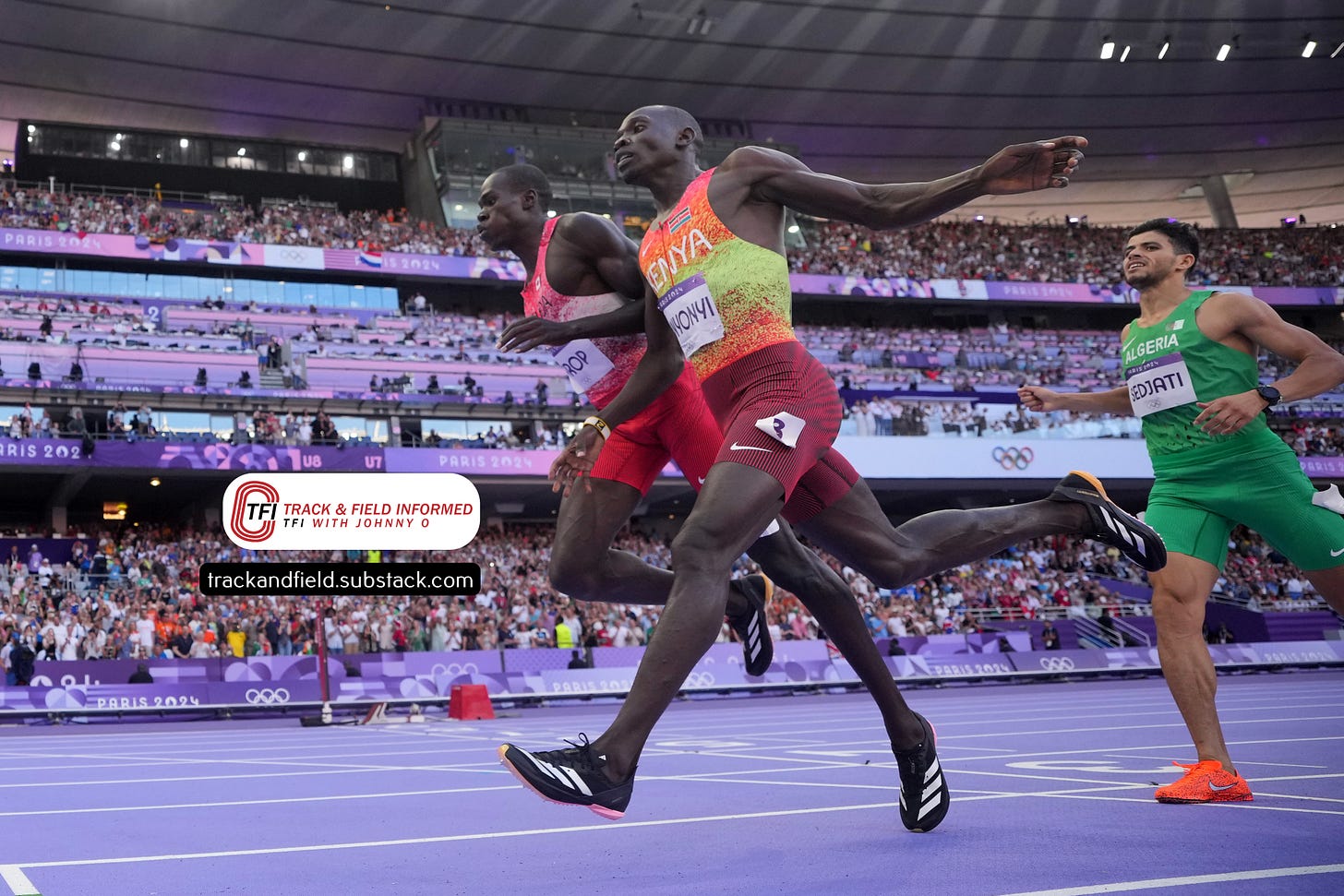
5) Letsile Tebogo (Botswana) – The versatile 21-year-old sprinter became the first African to win an Olympic title in the men’s 200 meters when he clocked 19.46 in Paris to move to fifth on the all-time performer list. That performance came four days after he had lowered his national record in the 100 to 9.86 while finishing sixth in an historically deep race. In addition to his performances in the 200 and 100, he set a world best of 30.69 in the 300 in February and lowered his personal best to 44.29 in the 400 in March. He was also a dynamic performer in the 4 x 400 relay as he produced splits of 43.49 and 43.79 in the World Athletics Relays in the Bahamas in May before clocking 44.33 on the opening leg in a first-round heat in the Olympics and a scintillating 43.04 anchor carry in the final when a Botswanan foursome clocked 2:54.53 to finish a tenth of a second behind the first-place U.S. squad with the third-fastest time in history.
6) Jakob Ingebrigtsen (Norway) – The 2021 Olympic champion in the 1,500 meters went from first place to fourth in the final 60 meters of a sensational race in Paris, but he bounced back to win the 5,000 four days later before slashing more than three seconds off the world record in the 3,000 with a 7:17.55 clocking in the Kamila Skolimowska Memorial in Chorzow, Poland, in late August. Now 24, his season also included a 3:26.73 clocking in the 1,500 that tightened his hold on fourth on the all-time performer list and was the sixth fastest ever run. In addition, he won both the 1,500 and 5,000 in the European Athletics Championships in Rome in June and was victorious in six of nine finals in the 1,500 or mile during the season.
7) Jordan Alejandro Diaz (Spain) – The 23-year-old native of Cuba became eligible to represent Spain in June and promptly produced the third-longest triple jump in history in the European championships when his leap of 18.18 meters (59 feet 7¾ inches) turned back an outstanding 18.04 (59-2¼) effort from 2021 Olympic champion Pedro Pichardo of Portugal. The pair clashed again in the Olympic Games in Paris, where Diaz’ best of 17.86 (58-7¼) left him two centimeters in front of silver medalist Pichardo. Diaz was undefeated in six finals on the year, with the first two victories coming indoors.
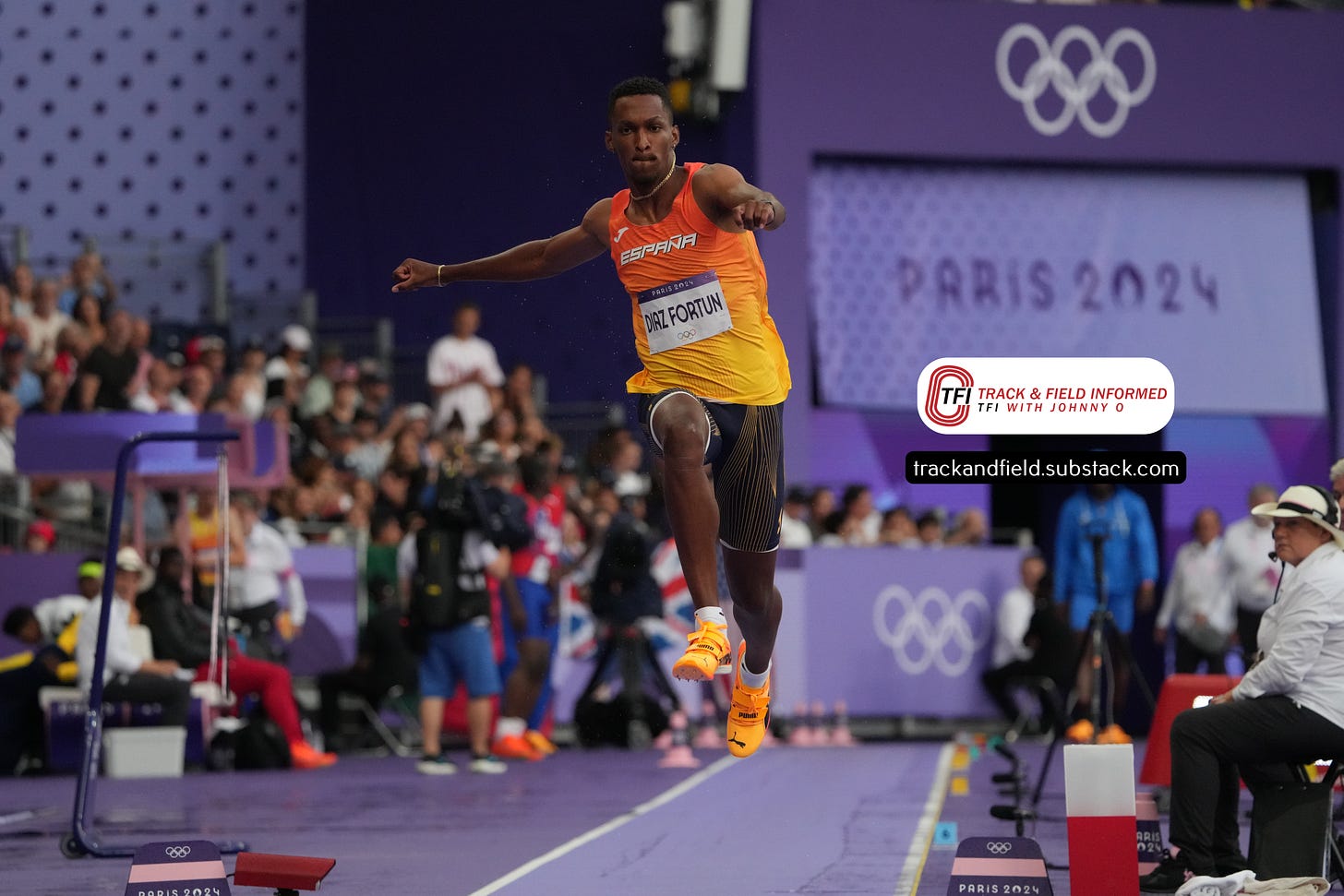
8) Ethan Katzberg (Canada) – The 22-year-old hammer thrower won the Olympic title by more than four meters as his winning throw of 84.12 (276-0) gave him his 10th consecutive victory during a season in which he won 11 of 12 meets. His season began with a bang when his 84.38 (276-10) best in the Kip Keino Classic in Nairobi in April moved him to ninth on the all-time performer list and was the farthest throw in the world since 2008. He threw more than 80 meters (262-5) in nine meets during a year when six other throwers combined to do that 10 times.
9) Noah Lyles (U.S.) – The 27-year-old performer was on top of the sprint world after coming from behind to win the 100 in the Olympic Games in an historically deep race, but he finished third in the 200 four days later when he was at less than his best after after testing positive for COVID-19. His 9.79 clocking in the 100 in the Olympic final moved him into a tie for 12th on the all-time performer list and his season best of 19.53 in the 200 was the second fastest of the year in that event. He won five of six finals in the 100 and was victorious in two of three 200-meter races.
10) Ryan Crouser (U.S.) – The shot putter who turned 31 last month won an unprecedented third consecutive Olympic title in Paris after winning his first gold medal in the World Athletics Indoor Championships in March. Although injuries and elbow surgery delayed the start of his outdoor season until the U.S. Olympic Team Trials in late June, he won that meet and went on to dominate the Olympic final with a best of 22.90 (75-1¾) during a competition in which his third-longest put of 22.64 (74-3½) was significantly better than the 22.15 (72-8) bests of the silver and bronze medalists. Although Crouser’s season best of 22.93 (75-2¾) ranked third on the yearly world performer list behind fellow American Joe Kovacs at 23.13 (75-10¾) and Italian Leonardo Fabbri at 22.98 (75-4¾), he won eight of 11 competitions and had a 7-1 record against Kovacs and a 7-2 mark versus Fabbri.
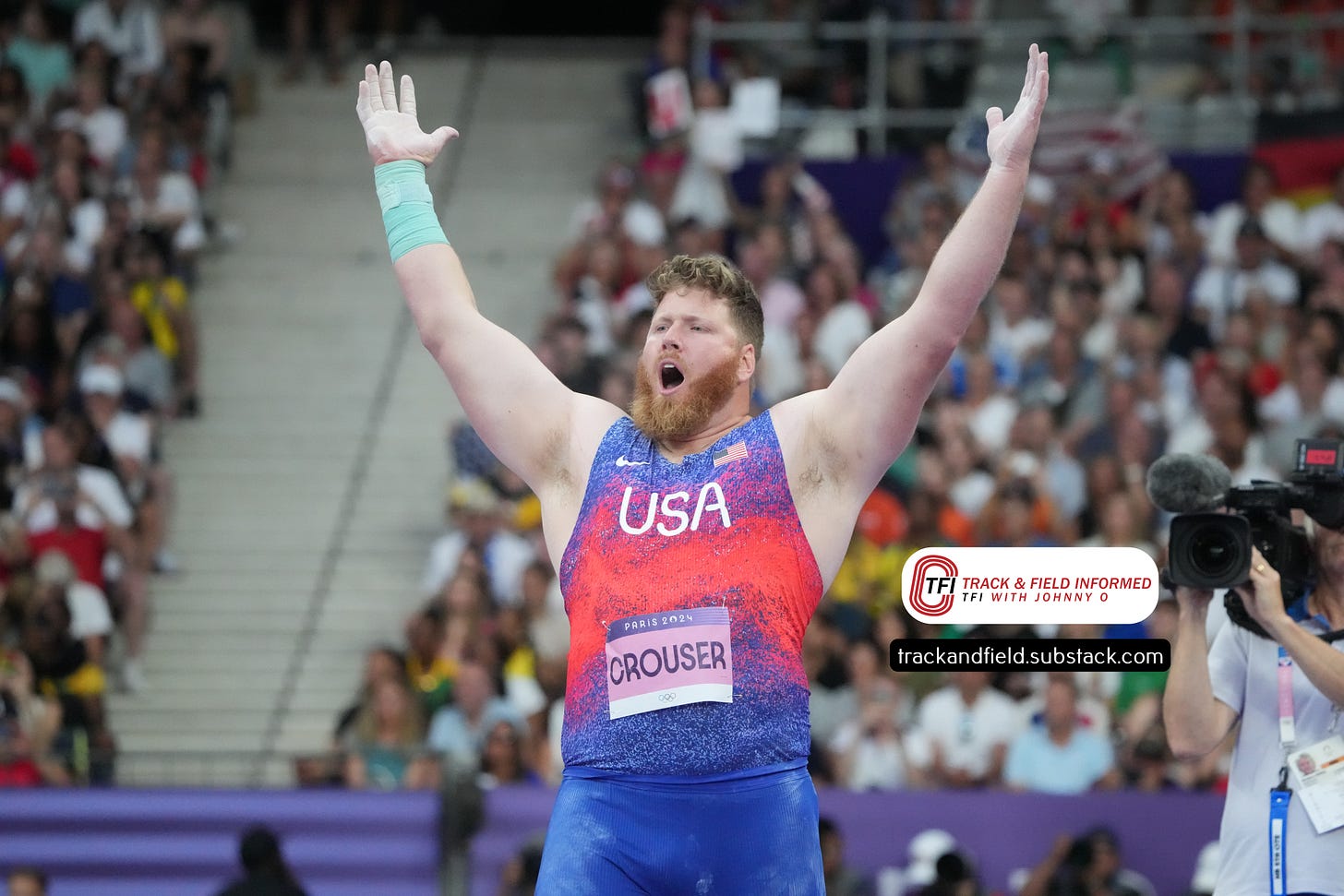
Honorable mention (in alphabetical order): Mykolas Alekna (Lithuania), Quincy Hall (U.S.), Leo Neugebauer (Germany), Miltiadis Tentoglou (Greece).



